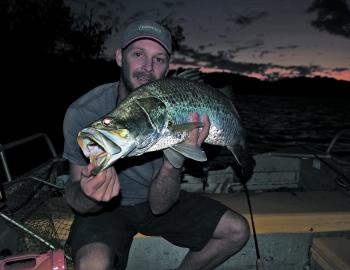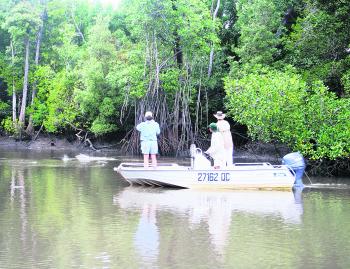The El Nino has created a desperate lack of activity along the monsoonal trough, with not a single cyclone crossing our coast so far. This can lead to some awesome localised fishing early in the season, especially along the Gulf Coast. However, it does not bode well for later in the dry season and for the years following.
Easter comes early this year and odds are that access to the Cape should be well and truly open. Lets hope there is a late wet-season-kick and good rains before the long weekend to allow fish such as sooty grunter, coal bream, saratoga, barramundi, tarpon, archer fish and mangrove jack to reach some of those upstream pools.
A close inspection of the Cape York map will reveal a massive block of land, dissected by streams, creeks and rivers. There is barely a pond of water that won’t hold fish at some stage or another. It is amazing where black bream can be found during the wet season, often in spots that were dry, desert-looking rock pools only months before.
Some of the iconic species of the Cape like to transition between the fresh, salt and brackish waters. Saratoga are a classic example of this. Found only in the western draining systems, these fish will show up around the fresh-salt transition zone following each wet season, often leaving anglers a little mystified they have caught them so far downstream.
Medium bodied, brightly coloured lures fitted with super sharp hooks will account for plenty of toga at this time of year. Look for large logjams at creek bends in areas adjacent to lily pads or shady structure nearby. The strike is often visual, being either on the surface as the lure crashes down, or very close as the lure dips just under water. Some great soft plastic frog-imitations will also account for togas during fresh-water run-off time.
Bronze-tinged barra that have been holding in far-upstream and land-locked waterholes will also fill these brackish waters during the run-off. Anglers will have a great time catching 35-55cm fish on shallow divers, fishing the areas just upstream from the salt. These fish are suckers for a suspended lure twitched ever-so-slowly past structure. Look for green bushes that have fallen into the system during the last few months and have a little bit of current ripping past them. Cast upstream of these spots and twitch the lure down about a foot below the surface, to make it suspend as it travels past the outside twigs.
Telltale signs that barra are holding in a spot is a silver flash, followed by a boil behind your lure. Repeated casts may be necessary to get them fired up. Quite often, anglers will drift past an area holding heaps of barra when they fail to hook shy fish on the first pass. Gently placing an anchor over the side just upstream of the structure and making repeated casts in this fashion will yield a better catch tally at the end of the day.
Inexperienced anglers don’t often see the value in catching small rat-barra. These days with the huge impoundment fish filling the social media annals, anglers can be forgiven for downplaying their own small-scale captures. But keep this firmly in mind – a wild caught barramundi, even a small one caught twitching your lure seductively near the surface will count for a huge amount when it comes time to tussle with that reclusive big girl. Knowing when to pause, when to twitch and when to strike are valuable lessons best learnt on smaller fish!
Reads: 1121
Big barra will swallow your lure whole if you are out at the right time!

Fishing structure like this will see you hooked up to a barra or a toga in no time!

Recent rains have inundated floodplains, which in turn has switched the barra into feeding mode.

An angler attempts to compose himself as he approaches predators smashing bait.




